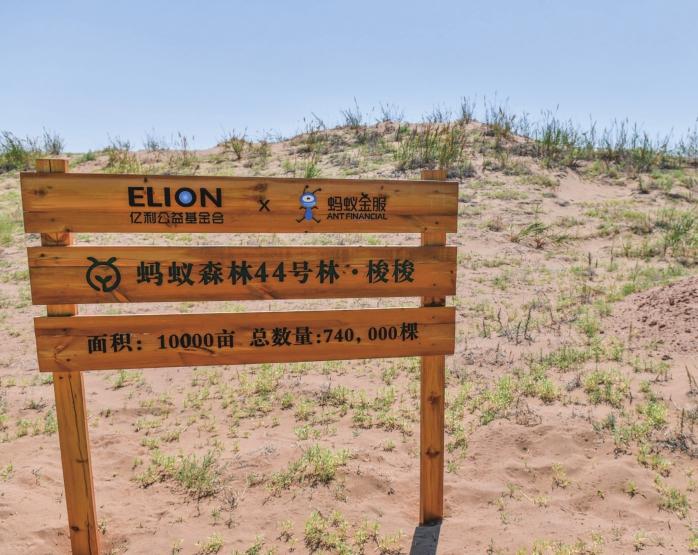VIRTUAL ENERGY,REAL TREES
2019-09-09ByMaMiaomiao
By Ma Miaomiao
Every morning at about 7:20, Liu Jiahui opens Alipay, Chinas leading mobile payment platform, on his phone. He waits for his “virtual green energy” to “mature” in order to collect points that will eventually lead to the planting of a real tree.
All his user activity that is considered lowcarbon is counted and converted into virtual green energy. When Liu has enough points in his personal carbon account to plant a virtual tree, a real one is planted in desert areas by local people with the support of Ant Financial, an affiliate of e-commerce giant Alibaba, the National Afforestation Committee and some nonprofit organizations.

So far, he has successfully “planted” five real trees in desert areas in northwest Chinas Gansu Province and Inner Mongolia Autonomous Region in the north.
Liu, a 29-year-old living and working in Beijing, is representative of the young generation who are actively participating in the worlds first large-scale pilot activity, launched in August 2016, to motivate peoples green behavior and reduce carbon dioxide emissions through the use of digital technologies and social media.
Local practice
The first tree that Ant Forest, the afforestation scheme on Alipay, helped Liu plant was a saxaul after he amassed 17.9-kg energy points, in Minqin County in Wuwei City, Gansu, which is surrounded on three sides by the Badain Jaran and Tengger deserts, the third and fourth largest in China, respectively.
Saxaul trees are often bent in gnarly shapes by the wind and their leaves are small, helping to conserve water. A full-grown saxaul tree, known as a desert guardian, can hold together a 10-square-meter patch of sandy land. It is one of the most suitable trees for Minqin, which lacks water and has serious soil salinization and desertification issues.
Over the past three years, with the joint efforts of various parties, an afforestation model has been set up. The users of Ant Forest earn and collect energy points on the scheme, and then Ant Financial donors fund local partners to plant real trees, said Eric Jing, Ant Financial CEO.
The project is mainly managed by nonprofit organizations such as the China Green Foundation (CGF), the ELION Foundation and the Society of Entrepreneurs and Ecology Foundation, and is supervised through advanced technologies.
The Shiyang River Forestry General Farm in Wuwei, established in 1964, is a partner that was selected to work on the Ant Forest project in Minqin for two years. So far, it has planted 8.64 million trees since 2018. Xue Wenrui, deputy head of the farm, told Beijing Review. “Because our farm has been concentrating on desertification control since the 1960s, we have the technologies, experience and confidence to carry out this project successfully.”
The one-year survival rate of the planted trees is supposed to be 75 percent, while the three-year rate should be 70 percent, 5 percent higher than the national standard, which is a requirement of the program. “In our case, the number was about 88 percent last year, according to onsite measurements,” Xue said.
The ELION Resources Group, an ecological company based in Inner Mongolia, has been an Ant Forest partner in Minqin since 2017. The company has introduced its greening experience from the Kubuqi Desert, the seventh largest desert in China, into the local practice to increase the survival rate of saxaul trees, said Zhang Kaizhen, Vice General Manager of ELION in Gansu.
The Ant Forest practice has created an effective model for private enterprises as well as for more people to participate in these efforts, Xue added. In addition, the project has aligned itself with the 4,500-km Great Green Wall project stretching along the edges of the northern deserts to combat land degradation and control desertification. Once the target is met by 2050, the new forest area will cover more than 42 percent of Chinas land mass.
But as they gradually move deeper into the core of the deserts, Ant Financials partners are facing greater challenges as the geological conditions get worse and the cost of labor and materials rises, while investment is relatively insufficient.
Moreover, the sand must be stabilized before trees can be planted. According to current conditions, there are still sand dunes of more than 670,000 hectare that need to be controlled in Minqin. The county, which stepped out of poverty in 2018, is short of funds for stabilizing the sand. “Things would be more promising if more social forces get involved,” Xue said.
Third-party monitoring
“Being an active user of the scheme, I sometimes wonder whether they have really planted the trees and if so, how they are maintained once planted,” Liu said to Beijing Review, a doubt many users must share.
According to Xue, the National Academy of Forestry Investigation and Planning, entrusted by the National Afforestation Committee and the CGF, dispatches experts to conduct onsite inspections after the trees are planted in Minqin.
Technologies such as artificial intelligence, drones and remote sensing satellites have also been introduced to help. Beijing-based GaGo Group and Guangzhou-based XAG Co. Ltd., two smart agriculture solution providers, monitor the trees through satellites, which take images of the desert regions before and after the tree planting to show users the real impact of their everyday actions.
Assisted by drones, local managing staff members can accurately calculate the health status of the trees and their survival rate.
Rangers working in the area also take photos of the trees during daily maintenance and upload them to the scheme. Users can then see the growth of their trees thousands of miles away on their mobile phones, Xue added.
Further exploration
“Increasing pressure on the environment is damaging the ecosystem and threatening the lives of millions of people. But the world is fighting back,” said Jing. Emerging digital technologies are enabling a mass approach to the battle, which complements actions such as the Paris Agreement and the United Nations 2030 Agenda for Sustainable Development, with the general public making changes in their own lives, he added.

“Two hundred million people—3 percent of the worlds population—are greening their lives because they are getting immediate information about the environmental impact of their choices in a fun and competitive way,” said a report on Ant Forest released at the Third Session of the UN Environment Assembly in 2017.
“The success of the program is a sign of the powerful change we can create when people are provided with the opportunity to live a greener life,” Jing said.
ELIONs Zhang said that such an antidesertification movement with large-scale afforestation cannot be realized without the participation of the public.
On April 22, World Earth Day, Alipay announced that with the active users of Ant Forest reaching 500 million, 122 million trees have been planted in desert areas, covering nearly 93,000 hectare. Its users have also helped reduce carbon dioxide emissions by 7.9 million tons.
The digital public service model of Ant Forest is being introduced overseas as well. The GCash Forest, the Ant Forest version in the Philippines, was launched on June 25. It attracted more than 700,000 users in its first month of operation, according to a local newspaper. GCash is the largest mobile wallet in the Philippines.
In the next three years, Ant Forest will continue to introduce the project to the world as a Chinese solution. With the support of its 1,000 ecological partners, the company hopes to encourage 1 billion people to engage in green and low-carbon consumption, it said in a report marking the third anniversary of the scheme.
